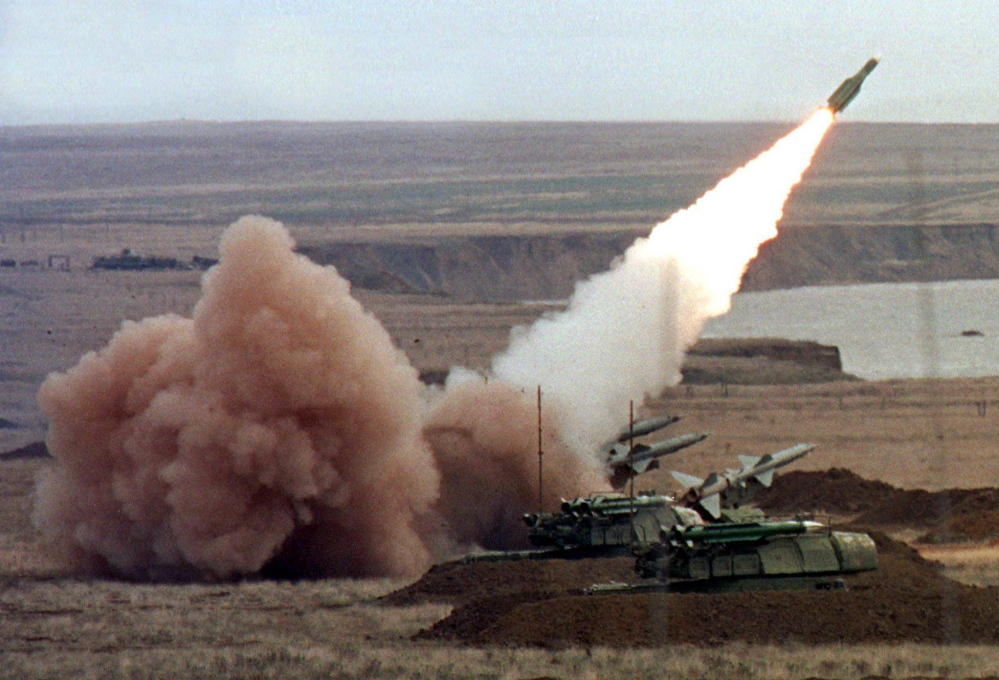SNIZHNE, Ukraine — It was lunchtime when a tracked launcher with four SA-11 surface-to-air missiles rolled into town and parked on Karapetyan Street. Fifteen hundred miles to the west, passengers were checking in for Malaysia Airlines Flight 17.
It had been a noisy day in this eastern Ukrainian town, residents recounted. Plenty of military equipment was moving through. But still it was hard to miss the bulky missile system, also known as a Buk M-1. It left deep tread marks in the asphalt as it rumbled by in a small convoy.
The vehicles stopped in front of journalists from The Associated Press. A man wearing unfamiliar fatigues, speaking with a distinctive Russian accent, checked to make sure they weren’t filming. The convoy then moved on, destination unknown in the heart of eastern Ukraine’s pro-Russia rebellion.
Three hours later, people six miles west of Snizhne heard loud noises.
And then they saw pieces of twisted metal – and bodies– fall from the sky.
The rebel leadership in Donetsk has repeatedly and publicly denied any responsibility for the downing of Flight 17.
REBELS’ DENIALS CHALLENGED
Sergei Kavtaradze, a spokesman for rebel leader Alexander Borodai, repeated to the AP on Friday that no rebel units had weapons capable of shooting that high, and said any suggestions to the contrary are part of an information war aimed at undermining the insurgents’ cause.
Nevertheless, the denials are increasingly challenged by accounts of residents, the observations of journalists on the ground and the statements of one rebel official. The Ukrainian government has also provided purported communications intercepts that it says show rebel involvement in the shoot-down.
A highly placed rebel, speaking to the AP this week, admitted that rebels were responsible. He said a unit based in the hometown of ousted President Viktor Yanukovych, made up of both Russians and Ukrainians, was involved in the firing of an SA-11 from near Snizhne. The rebel, who has direct access to the inner circle of the insurgent leadership in Donetsk, said that he could not be named because he was contradicting the rebels’ official line.
The rebels believed they were targeting a Ukrainian military plane, this person said. Instead, they hit the passenger jet flying from Amsterdam to Kuala Lumpur. All 298 people aboard were killed.
Intercepted phone conversations released by the Ukrainian government appear to back up the contention they were unaware the aircraft was a passenger jet. In those tapes, the first rebels to reach the scene can be heard swearing when they see the number of bodies and the insignia of Malaysia Airlines.
Ukraine immediately blamed the rebels for the shooting. In an interview in Kiev this week, the Ukrainian counterterrorism chief, Vitaly Nayda, gave the AP the government’s version of the events of July 17. He said the account was based on information from intercepts, spies and resident tips.
Nayda laid the blame fully on Russia: He said the missile launcher came from Russia and was operated by Russians. The Russian Foreign Ministry on Friday declined to comment on either charge. Moscow has continually denied involvement in the downing of the plane.
RUSSIA’S ROLE
The rebel official who spoke to AP did not address the question of any Russian government involvement in the attack. U.S. officials have blamed Russia for creating the “conditions” for the downing of the plane, but have offered no evidence that the missile came from Russia or that Russia directly was involved.
According to Nayda, at 1 a.m. on July 17 the launcher rolled into Ukraine across the Russian border aboard a flatbed truck. He cited communications intercepts that he would not share with the AP. By 9 a.m., he said, the launcher had reached Donetsk, the main rebel stronghold 125 miles from the border. In Donetsk it is presumed to have been off-loaded from the flatbed and started to move in a convoy on its own.
Nayda said the Buk turned back east toward Snizhne. Townspeople who spoke to the AP said it rolled into Snizhne around lunchtime.
Even before the plane was downed, the AP had reported on the presence of the missile launcher in the town July 17.
Here is what that dispatch said: “An Associated Press reporter on Thursday saw seven rebel-owned tanks parked at a gas station outside the eastern Ukrainian town of Snizhne. In the town, he also observed a Buk missile system, which can fire missiles up to an altitude of 72,000 feet.”
About three hours later, at 4:18 p.m., according to a recording from an intercepted phone call that has been released by Ukraine’s government, the Buk’s crew snapped to attention when a spotter called in a report of an incoming airplane.
At about 4:20 p.m., in the town of Torez, six miles west of Snizhne, residents heard loud noises.
As for the Buk, Nayda said, intelligence suggests it went back on the move shortly after the attack.
That very night, he said, it crossed the border, back into Russia.
Copy the Story LinkSend questions/comments to the editors.



Success. Please wait for the page to reload. If the page does not reload within 5 seconds, please refresh the page.
Enter your email and password to access comments.
Hi, to comment on stories you must . This profile is in addition to your subscription and website login.
Already have a commenting profile? .
Invalid username/password.
Please check your email to confirm and complete your registration.
Only subscribers are eligible to post comments. Please subscribe or login first for digital access. Here’s why.
Use the form below to reset your password. When you've submitted your account email, we will send an email with a reset code.